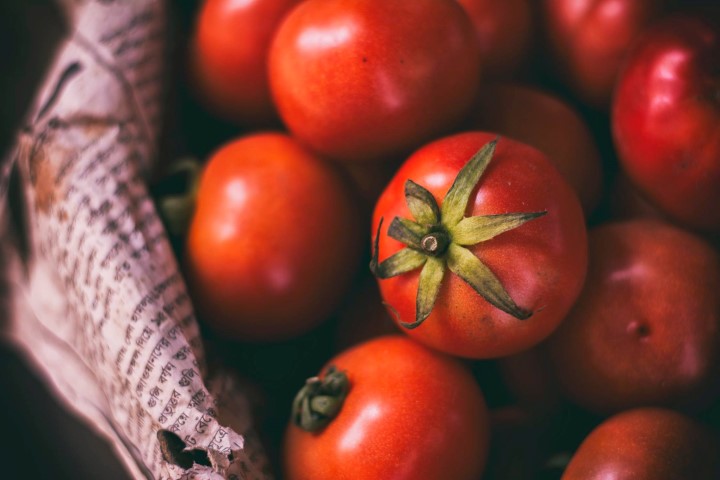To-may-toe, to-mah-toe, red and juicy. This berry has long been sparking the debate of whether it is to be classified as a vegetable or fruit. However you pronounce it, or whichever family you decide it belongs to, there’s no denying its exemplary nutritional benefits. Packed with vitamins C, A and K in addition to potassium and the infamous cancer-fighting lycopene, this red succulent item should be included in your meals as often as possible.
Men have been continually encouraged to consume as many tomatoes as possible in an effort to reduce their prostate cancer risk. Studies have also shown positive results for those who have already been exposed to dreadful cancer. Contrary to popular belief, it’s not the lycopene in tomatoes which fights the cells that cause prostate cancer; it’s actually a nutrient known as alpha-tomatine. Research has proven that the alpha-tomatine has shown the ability to change the metabolic activity in developing prostate cancer cells. It’s also shown to trigger programmed cell death (apoptosis) in prostate cancer cells that have already been formed. Lycopene has however been shown to reduce the risk of pancreatic cancer.
Tomatoes have many other antioxidant properties alongside lycopene which also combat other life-threatening cancers. Acids in tomatoes block compounds found in processed meats from starting the process of cancer cell formation. Lycopene is very powerful in the prevention of high cholesterol. Its antioxidant properties aid in the breakdown of plaque which may block arteries which could have resulted in a heart attack. Hence, tomatoes are also excellent for heart health. In women, lycopene, alpha-carotene, lutein and other phytochemicals have been shown to reduce the risk of both ovarian and breast cancer prior to and after menopause.
Raw or cooked, does it matter?
The content of lycopene is higher when tomatoes are cooked, but more vitamin C is contained in raw tomatoes. However, whether cooked or raw, unpeeled tomatoes retain higher contents of all their nutrients and phytochemicals. It is therefore advised to include a combination of both cooked and raw tomatoes in our daily diet. In some instances, tomatoes may seem too acidic depending on how they are prepared, however, adding carrots may assist in reducing acidity while increasing fibre and carotenoids without compromising flavour.
To Read More: Purchase your copy of Volume 9 #4– September-October 2017


Share this post:
To-may-toe, to-mah-toe, red and juicy. This berry has long been sparking the debate of whether it is to be classified as a vegetable or fruit. However you pronounce it, or whichever family you decide it belongs to, there’s no denying its exemplary nutritional benefits. Packed with vitamins C, A and K in addition to potassium and the infamous cancer-fighting lycopene, this red succulent item should be included in your meals as often as possible.
Men have been continually encouraged to consume as many tomatoes as possible in an effort to reduce their prostate cancer risk. Studies have also shown positive results for those who have already been exposed to dreadful cancer. Contrary to popular belief, it’s not the lycopene in tomatoes which fights the cells that cause prostate cancer; it’s actually a nutrient known as alpha-tomatine. Research has proven that the alpha-tomatine has shown the ability to change the metabolic activity in developing prostate cancer cells. It’s also shown to trigger programmed cell death (apoptosis) in prostate cancer cells that have already been formed. Lycopene has however been shown to reduce the risk of pancreatic cancer.
Tomatoes have many other antioxidant properties alongside lycopene which also combat other life-threatening cancers. Acids in tomatoes block compounds found in processed meats from starting the process of cancer cell formation. Lycopene is very powerful in the prevention of high cholesterol. Its antioxidant properties aid in the breakdown of plaque which may block arteries which could have resulted in a heart attack. Hence, tomatoes are also excellent for heart health. In women, lycopene, alpha-carotene, lutein and other phytochemicals have been shown to reduce the risk of both ovarian and breast cancer prior to and after menopause.
Raw or cooked, does it matter?
The content of lycopene is higher when tomatoes are cooked, but more vitamin C is contained in raw tomatoes. However, whether cooked or raw, unpeeled tomatoes retain higher contents of all their nutrients and phytochemicals. It is therefore advised to include a combination of both cooked and raw tomatoes in our daily diet. In some instances, tomatoes may seem too acidic depending on how they are prepared, however, adding carrots may assist in reducing acidity while increasing fibre and carotenoids without compromising flavour.
To Read More: Purchase your copy of Volume 9 #4– September-October 2017
Share this post: